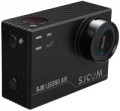Thread 1/4" (for tripod)
The presence of a
1/4" threaded socket on the camera body. It is this size that is standard for modern
tripods and is used in most of these devices. So this feature allows you to mount the camera on a tripod without using adapters and other additional equipment.
Quad HD
The ability of the camera to shoot QuadHD video.
This standard includes an extensive set of resolutions — from 1440 to 3456 pixels horizontally and from 1440 to 2160 pixels vertically, with almost two dozen intermediate options. It is a rather specific transitional option between the relatively inexpensive FullHD 1080p and the demanding UltraHD 4K, allowing you to shoot higher resolution video than 1080p without significantly increasing the cost of equipment. Note that pure QuadHD resolutions are rare in TVs and monitors, but modern technologies make it possible to comfortably watch videos of this format on any high-resolution screen.
Another important parameter given in this paragraph is the frame rate. The higher it is, the smoother the movement in the frame will be, and the details in dynamic scenes will be visible clearly. For example, a filming speed of
25 fps or
30 fps approximates the standard frame rate in film and television; such an image is quite viewable, but fast-moving objects in the frame will look blurry. With an increase in speed to
60 fps, this effect becomes almost imperceptible. The highest QuadHD frame rate found in modern action cameras is
120 fps; this frequency is used when shooting slow-motion video (as well as models with a frequency of
100 fps) because at a n
...ormal playback speed, 60 fps is enough.Ultra HD (4K)
The ability of the camera to shoot Ultra HD 4K video.
This format covers several resolutions in which the horizontal frame size is approximately 4K pixels. The most popular in action cameras is 3840x2160 (twice the FullHD frame on each side), but there are other options — for example, 3840x1920, corresponding to an aspect ratio of 2:1. In general, 4K is a kind of successor to Full HD: among HD standards that surpass Full HD, UltraHD is the most popular, in particular, many advanced TVs are produced with 3840x2160 screens. On the other hand, this format is quite demanding in terms of processing power and memory, so it is relatively rare in action cameras, mainly among premium models.
Another important parameter given in this paragraph is the frame rate. The higher it is, the smoother the movement in the frame will be, and the details in dynamic scenes will be visible clearly. However, in UltraHD mode, most modern action cameras produce a very low frame rate — most often
30 fps, and in some models
24 fps or even
15 fps. This video is quite viewable, but fast movement in the frame may look blurry. There are cameras capable of shooting UltraHD at a solid speed of
60 fps — the blurring effect during such shooting is almost imperceptible. However, such a model cost is high.
Megapixels
The number of megapixels in the action camera sensor, in other words, the resolution of this sensor(1 megapixel is 1 million photosensitive points).
There is an opinion that the higher the resolution, the better the image quality. It is true from the point of view that manufacturers are trying to install high-resolution sensors in advanced cameras. At the same time, there are no strict dependencies here, and from the technical point of view, the number of megapixels determines only the maximum image resolution that can be captured using this sensor. The quality of this picture will depend both on several features of the sensor itself (size, type, special design solutions), and the specs of the camera. So when choosing, you should focus not so much on the resolution of the image sensor, but on the general class of the camera and reviews with examples of footage.
Battery model
The model name of the proprietary battery used in the camera. Knowing this name, you can easily find a spare or replacement battery for the device.

